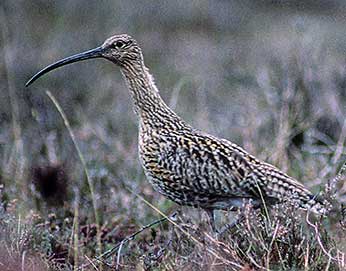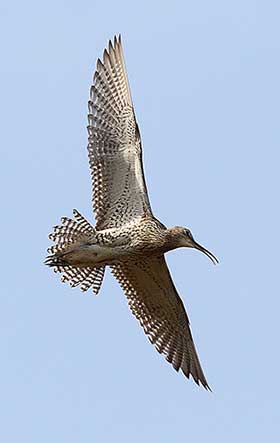Curlew (Numenius arquata)
When: Earlly March to early August
How many: Relatively small numbers, and declining, but from March until the beginning of May, particularly early in the day, they can be conspicuous

The curlew’s familiar, plaintiff, bubbling cries - coorlee, coorlee, coorlee - brighten many of the larger New Forest heaths and valley mires as these attractive birds establish and defend their breeding territories. In fact, this hauntingly beautiful, wilderness sound is as much a sign of spring as the arrival of the first swallows or the earliest cuckoo’s calls.
Bulky, long-legged, white-rumped creatures, curlews are Europe’s largest wader with a wing span of up to 106 centimeters (42 inches). Their lengthy, down-curved bill is distinctive, an adaption that allows mud and soft ground to be probed for invertebrates, prey to be taken off the surface, and tussocks and other vegetation explored in the search for tasty morsels.
In the New Forest, curlews can hardly be confused with any other bird as they patrol their domains in spectacular, undulating display flight, calling as they go, in regularly repeated early morning rituals.
Indeed, the New Forest heaths and bogs would be all the duller without the curlews’ wailing, mournful sounds and accompanying antics. Yet it once was so, for curlews are relatively recent arrivals, a welcome wildlife success story that has unfolded since the second half of the 19th century.
Prior to that, as breeding birds, curlews were restricted to Britain’s uplands: to the wilder parts of Dartmoor, Exmoor, Wales, and Shropshire, and from the lower Pennines northwards into Scotland. But by 1890, small numbers were breeding in the New Forest, and by 1960, around 60 pairs bred. Elsewhere, breeding was first recorded in Wiltshire, Dorset and Lancashire in the 1870s and in Cheshire in the 1890s. Range expansion continued, and by the mid-20th century, curlews were breeding in many of Britain’s river valleys and on agricultural land.
Curlews arrive in the New Forest from early-March, but initially some are thought to be regular commuters, spending parts of the day on the breeding grounds but returning to feed on the coast.
Curlew nests, not much more than large depressions sparsely lined with vegetation, are constructed in and around the valley bogs and wetter heaths, often on a tussock or low hummock. Four green to olive coloured eggs are usually laid, blotched with brown and grey. Incubation lasts for around 28 days, and on hatching, the youngsters are already covered with fluffy down, and are almost immediately mobile. The fledgling period can last for up to 38 days.

As the breeding cycle progresses, particularly after the eggs have hatched, calling and display gradually ceases as adult curlews quietly go about the business of raising their brood. Then, cryptically patterned, brown-streaked plumage makes them surprisingly inconspicuous. Indeed, had the earlier activity not been witnessed, presence would largely go unnoticed.
Most curlews leave the New Forest by late-July, although on the Hampshire coast, returning adults - failed breeders or females whose mates have been left to tend the chicks - are first noticed in late-June.
Breeding numbers in the wider countryside have shown a substantial decline in recent years, whilst in the New Forest, the results of a 2004 RSPB survey suggested that since 1994 numbers fell here by 25%, from 132 pairs to 99 pairs.
As at 2017, the downward trend, possibly associated with increasing recreational disturbance and / or habitat deterioration, has not been reversed by relatively recent, local wetland restoration initiatives and attempts, through selective car park closures, to limit disturbance in priority wetland areas.
In fact, a 2016 survey by members of Wild New Forest located only 40 breeding pairs, and in March 2017, Nigel Matthews, the New Forest National Park Authority's Head of Recreation, Management and Learning, told the Daily Echo: 'The New Forest curlew population is extremely important - in some ways it's a barometer for the well-being of wildlife in the area. Disturbance is likely to be a cause of the decline and it's vital we do all we can to reduce instances of birds being startled by people. Working with other Forest organisations, we have helped design new signs for use across the open forest this year. The signs make it clear that walkers and their dogs, cyclists and horse riders should all stay on the main tracks when crossing heathland from now until August.'
However, whilst reducing disturbance in the New Forest is clearly important, other factors are also likely to be in play as the British Trust for Ornithology (BTO) in 2017 reported that nationally 'the Curlew is one of our most rapidly declining breeding bird species, showing a 46% decline across the UK from 1994-2010, with this figure exceeding 50% in Wales and Scotland' (where in many places, disturbance is unlikely to be a significant factor).
In response to the declines, the curlew has recently been listed as globally near-threatened, one of the few British species on this list, and the BTO has launched an appeal to help raise money to fund research.
They say: 'There is an extremely urgent need to identify the causes of these declines as a necessary first step to introducing potential conservation interventions. Possible reasons for the declines include:
- Increases in generalist predators reducing breeding success
- Afforestation of marginal hill land
- Changes in farming practice reducing habitat quality
- Climate change'
References:
The Birds of the Western Palearctic: Stanley Cramp, et al.
The Historical Atlas of Breeding Birds in Britain and Ireland, 1875-1900: Simon Holloway
Birds of Hampshire: Hampshire Ornithological Society
Hampshire Bird Report 2004: Hampshire Ornithological Society
The New Forest – A Natural History: Colin R. Tubbs
New Forest Breeding Waders Survey 2004: A Survey of the Breeding Waders in the New Forest Valley Mires: R.D. Goater, C. Temple and A. Thomas
More links
Other related links
Search this site

Sadly, 58 animals were killed - 35 ponies, 13 cows, 8 donkeys and 2 sheep, whilst a further 32 were injured - 3 pigs, 9 donkeys, 11 cows and 9 ponies.
(Forty-three accidents occurred in daylight, 15 at twilight and 101 in the dark. Twenty-seven accidents were not reported by the driver involved).
Here's just one horrific example - Three donkeys killed in collision with van at notorious New Forest blackspot (Advertiser and Times)

